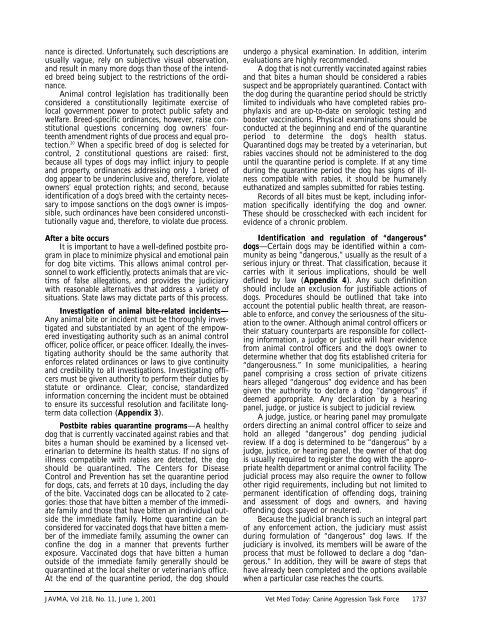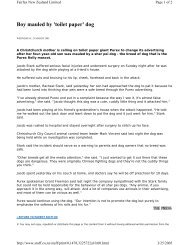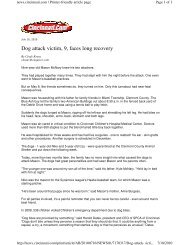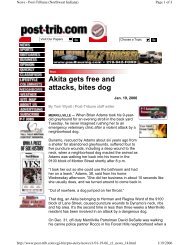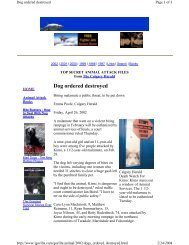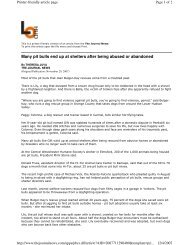A community approach to dog bite prevention - American Veterinary ...
A community approach to dog bite prevention - American Veterinary ...
A community approach to dog bite prevention - American Veterinary ...
Create successful ePaper yourself
Turn your PDF publications into a flip-book with our unique Google optimized e-Paper software.
nance is directed. Unfortunately, such descriptions are<br />
usually vague, rely on subjective visual observation,<br />
and result in many more <strong>dog</strong>s than those of the intended<br />
breed being subject <strong>to</strong> the restrictions of the ordinance.<br />
Animal control legislation has traditionally been<br />
considered a constitutionally legitimate exercise of<br />
local government power <strong>to</strong> protect public safety and<br />
welfare. Breed-specific ordinances, however, raise constitutional<br />
questions concerning <strong>dog</strong> owners’ fourteenth<br />
amendment rights of due process and equal protection.<br />
20 When a specific breed of <strong>dog</strong> is selected for<br />
control, 2 constitutional questions are raised: first,<br />
because all types of <strong>dog</strong>s may inflict injury <strong>to</strong> people<br />
and property, ordinances addressing only 1 breed of<br />
<strong>dog</strong> appear <strong>to</strong> be underinclusive and, therefore, violate<br />
owners’ equal protection rights; and second, because<br />
identification of a <strong>dog</strong>’s breed with the certainty necessary<br />
<strong>to</strong> impose sanctions on the <strong>dog</strong>’s owner is impossible,<br />
such ordinances have been considered unconstitutionally<br />
vague and, therefore, <strong>to</strong> violate due process.<br />
After a <strong>bite</strong> occurs<br />
It is important <strong>to</strong> have a well-defined post<strong>bite</strong> program<br />
in place <strong>to</strong> minimize physical and emotional pain<br />
for <strong>dog</strong> <strong>bite</strong> victims. This allows animal control personnel<br />
<strong>to</strong> work efficiently, protects animals that are victims<br />
of false allegations, and provides the judiciary<br />
with reasonable alternatives that address a variety of<br />
situations. State laws may dictate parts of this process.<br />
Investigation of animal <strong>bite</strong>-related incidents—<br />
Any animal <strong>bite</strong> or incident must be thoroughly investigated<br />
and substantiated by an agent of the empowered<br />
investigating authority such as an animal control<br />
officer, police officer, or peace officer. Ideally, the investigating<br />
authority should be the same authority that<br />
enforces related ordinances or laws <strong>to</strong> give continuity<br />
and credibility <strong>to</strong> all investigations. Investigating officers<br />
must be given authority <strong>to</strong> perform their duties by<br />
statute or ordinance. Clear, concise, standardized<br />
information concerning the incident must be obtained<br />
<strong>to</strong> ensure its successful resolution and facilitate longterm<br />
data collection (Appendix 3).<br />
Post<strong>bite</strong> rabies quarantine programs—A healthy<br />
<strong>dog</strong> that is currently vaccinated against rabies and that<br />
<strong>bite</strong>s a human should be examined by a licensed veterinarian<br />
<strong>to</strong> determine its health status. If no signs of<br />
illness compatible with rabies are detected, the <strong>dog</strong><br />
should be quarantined. The Centers for Disease<br />
Control and Prevention has set the quarantine period<br />
for <strong>dog</strong>s, cats, and ferrets at 10 days, including the day<br />
of the <strong>bite</strong>. Vaccinated <strong>dog</strong>s can be allocated <strong>to</strong> 2 categories:<br />
those that have bitten a member of the immediate<br />
family and those that have bitten an individual outside<br />
the immediate family. Home quarantine can be<br />
considered for vaccinated <strong>dog</strong>s that have bitten a member<br />
of the immediate family, assuming the owner can<br />
confine the <strong>dog</strong> in a manner that prevents further<br />
exposure. Vaccinated <strong>dog</strong>s that have bitten a human<br />
outside of the immediate family generally should be<br />
quarantined at the local shelter or veterinarian’s office.<br />
At the end of the quarantine period, the <strong>dog</strong> should<br />
undergo a physical examination. In addition, interim<br />
evaluations are highly recommended.<br />
A <strong>dog</strong> that is not currently vaccinated against rabies<br />
and that <strong>bite</strong>s a human should be considered a rabies<br />
suspect and be appropriately quarantined. Contact with<br />
the <strong>dog</strong> during the quarantine period should be strictly<br />
limited <strong>to</strong> individuals who have completed rabies prophylaxis<br />
and are up-<strong>to</strong>-date on serologic testing and<br />
booster vaccinations. Physical examinations should be<br />
conducted at the beginning and end of the quarantine<br />
period <strong>to</strong> determine the <strong>dog</strong>’s health status.<br />
Quarantined <strong>dog</strong>s may be treated by a veterinarian, but<br />
rabies vaccines should not be administered <strong>to</strong> the <strong>dog</strong><br />
until the quarantine period is complete. If at any time<br />
during the quarantine period the <strong>dog</strong> has signs of illness<br />
compatible with rabies, it should be humanely<br />
euthanatized and samples submitted for rabies testing.<br />
Records of all <strong>bite</strong>s must be kept, including information<br />
specifically identifying the <strong>dog</strong> and owner.<br />
These should be crosschecked with each incident for<br />
evidence of a chronic problem.<br />
Identification and regulation of “dangerous”<br />
<strong>dog</strong>s—Certain <strong>dog</strong>s may be identified within a <strong>community</strong><br />
as being “dangerous,” usually as the result of a<br />
serious injury or threat. That classification, because it<br />
carries with it serious implications, should be well<br />
defined by law (Appendix 4). Any such definition<br />
should include an exclusion for justifiable actions of<br />
<strong>dog</strong>s. Procedures should be outlined that take in<strong>to</strong><br />
account the potential public health threat, are reasonable<br />
<strong>to</strong> enforce, and convey the seriousness of the situation<br />
<strong>to</strong> the owner. Although animal control officers or<br />
their statuary counterparts are responsible for collecting<br />
information, a judge or justice will hear evidence<br />
from animal control officers and the <strong>dog</strong>’s owner <strong>to</strong><br />
determine whether that <strong>dog</strong> fits established criteria for<br />
“dangerousness.” In some municipalities, a hearing<br />
panel comprising a cross section of private citizens<br />
hears alleged “dangerous” <strong>dog</strong> evidence and has been<br />
given the authority <strong>to</strong> declare a <strong>dog</strong> “dangerous” if<br />
deemed appropriate. Any declaration by a hearing<br />
panel, judge, or justice is subject <strong>to</strong> judicial review.<br />
A judge, justice, or hearing panel may promulgate<br />
orders directing an animal control officer <strong>to</strong> seize and<br />
hold an alleged “dangerous” <strong>dog</strong> pending judicial<br />
review. If a <strong>dog</strong> is determined <strong>to</strong> be “dangerous” by a<br />
judge, justice, or hearing panel, the owner of that <strong>dog</strong><br />
is usually required <strong>to</strong> register the <strong>dog</strong> with the appropriate<br />
health department or animal control facility. The<br />
judicial process may also require the owner <strong>to</strong> follow<br />
other rigid requirements, including but not limited <strong>to</strong><br />
permanent identification of offending <strong>dog</strong>s, training<br />
and assessment of <strong>dog</strong>s and owners, and having<br />
offending <strong>dog</strong>s spayed or neutered.<br />
Because the judicial branch is such an integral part<br />
of any enforcement action, the judiciary must assist<br />
during formulation of “dangerous” <strong>dog</strong> laws. If the<br />
judiciary is involved, its members will be aware of the<br />
process that must be followed <strong>to</strong> declare a <strong>dog</strong> “dangerous.”<br />
In addition, they will be aware of steps that<br />
have already been completed and the options available<br />
when a particular case reaches the courts.<br />
JAVMA, Vol 218, No. 11, June 1, 2001 Vet Med Today: Canine Aggression Task Force 1737


